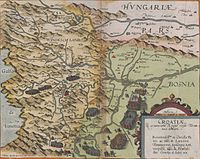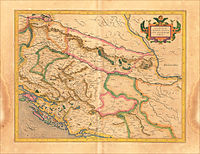Turkish Croatia

Turkish Croatia or Turkish Croatia ( Croatian Turska Hrvatska , Italian Croazia turca ) was a part of the Kingdom of Croatia conquered by the Ottomans during the 15th and 16th centuries . When it became apparent in the course of the 19th century that the Croats would disappear permanently as a result of conquest or annihilation, the name Bosanska Krajina ( Bosnian border area ) gradually gained acceptance . It stayed that way until today.
Turkish Croatia was roughly bordered in the east by the Vrbas River , in the northeast by the Save River , in the northwest by the Una River , in the west by the Cazinska krajina ( Cazines border area ) and in the south by the Dinara Mountains. Today this area is part of Bosnia and Herzegovina .
history
After the Croatian tribes settled the northeastern coast of the Adriatic Sea and its wide hinterland up to the Drava River in the north in the 7th century , the area of Turkish Croatia became a central and eastern part of the medieval Croatian kingdom (10th-12th centuries) . At that time, the term "Bosnia" was limited to a relatively small area along the upper part of the Bosna River , which in the east just reached the Drina River . It was not until the 14th century, when Croatia was weakened by the personal union with Hungary that had lasted for more than two centuries, that the medieval Bosnian state developed under King Stjepan Tvrtko I , who also included some parts of today's Croatia.
The fall of Bosnia into Ottoman hands in 1463 meant that Croatia came under increasing pressure and then (especially during the Hundred Years Croatian-Ottoman War between 1493 and 1593) gradually lost parts of its territory. By the end of the 16th century, the entire area of Turkish Croatia was conquered by the Turks. The remaining Croatians were either killed or deported to Turkey as a boy harvest . However, part of the Croatian people managed to flee the endangered territories. Some Croatians, on the other hand, adopted Islam in order to survive. Catholic churches were destroyed or converted into mosques ; Priests and bishops perished or fled.
After the Habsburg-Turkish War in 1878 and the fall of the Bosnian Vilayet , Turkish Croatia remained a part of Bosnia and Herzegovina, which at that time became a new Habsburg crown land. The country, largely renamed Bosanska krajina , was liberated at the time, but Croats hardly lived there.
Maps
Croatia after a partial conquest of the later Turkish Croatia. Is shown Bihac ( Wÿhitz ) in Turkish Croatia as an Ottoman frontier town ( de Jode Cornelis , 1593).
Croatia without the Ottoman-occupied Turkish Croatia on a map by Gerhard Mercator from 1609
Croatia including the Turkish Croatia area on a map by Matthäus Seutter from 1728
The Ottoman "Turkish Croatia" (outlined in green) on a map of the Illyrian provinces from 1813.
"Turkish Croatia" on a map of the European part of the Ottoman Empire by John Bartholomew from 1870.







